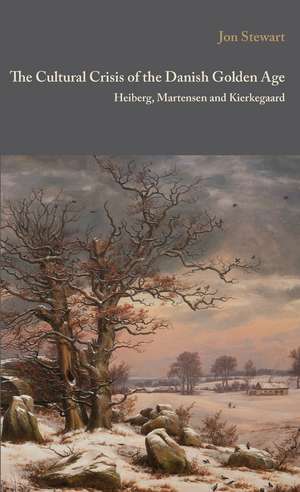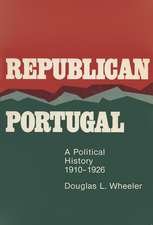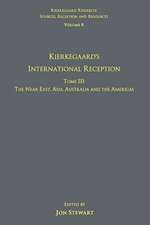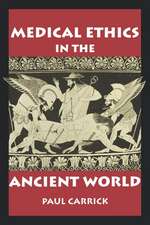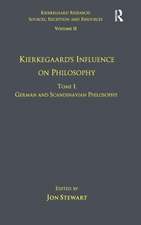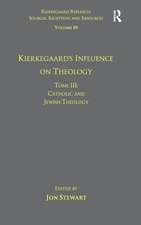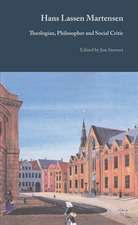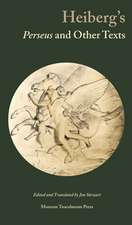The Cultural Crisis of the Danish Golden Age: Heiberg, Martensen, and Kierkegaard: Danish Golden Age Studies
Autor Jon Stewarten Limba Engleză Hardback – 8 oct 2015
The Danish Golden Age of the first half of the nineteenth century endured in the midst of a number of different kinds of crises—political, economic, and cultural. The many changes of the period made it a dynamic time, one in which artists, poets, philosophers, and religious thinkers were constantly reassessing their place in society. This book traces the different aspects of the cultural crisis of the period through a series of case studies of key figures, including Johan Ludvig Heiberg, Hans Lassen Matensen, and Søren Kierkegaard. Far from just a historical analysis, however, the book shows that many of the key questions that Danish society wrestled with during the Golden Age remain strikingly familiar today.
Preț: 368.56 lei
Preț vechi: 450.78 lei
-18% Nou
Puncte Express: 553
Preț estimativ în valută:
70.52€ • 73.78$ • 58.58£
70.52€ • 73.78$ • 58.58£
Carte disponibilă
Livrare economică 12-26 martie
Preluare comenzi: 021 569.72.76
Specificații
ISBN-13: 9788763542692
ISBN-10: 8763542692
Pagini: 337
Ilustrații: 15 halftones
Dimensiuni: 140 x 229 x 30 mm
Greutate: 0.7 kg
Editura: Museum Tusculanum Press
Colecția Museum Tusculanum Press
Seria Danish Golden Age Studies
ISBN-10: 8763542692
Pagini: 337
Ilustrații: 15 halftones
Dimensiuni: 140 x 229 x 30 mm
Greutate: 0.7 kg
Editura: Museum Tusculanum Press
Colecția Museum Tusculanum Press
Seria Danish Golden Age Studies
Notă biografică
Jon Stewart is associate professor at the Søren Kierkegaard Research Centre at the University of Copenhagen.
Cuprins
Acknowledgements
Abbreviations of Primary Texts
Preface
Introduction
Chapter 1. Quellenforschung and Kierkegaard’s Relation to Hegel: Some Methodological Considerations
1. Kierkegaard’s Critique of Universal Doubt: Martensen
2. Actuality in the Introduction to The Concept of Anxiety: Adler
3. References to the System in Prefaces: Heiberg
4. References to World History in the Concluding Unscientific Postscript: Grundtvig
5. Methodological Reflections
Chapter 2. Johan Ludvig Heiberg: Hegel’s Danish Apologist
1. Heiberg’s Life
2. Heiberg’s Philosophical Works
A. On Human Freedom and Der Zufall
B. Outline of the Philosophy of Philosophy or Speculative Logic
C. On the Significance of Philosophy for the Present Age
D. Introductory Lecture to the Logic Course
E. The First Volume of Perseus, Journal for the Speculative Idea
F. The Second Volume of Perseus, Journal for the Speculative Idea
G. Heiberg’s Article on the Law of Excluded Middle
H. “Autobiographical Fragments”
I. Heiberg’s Discussions of Either/Or and Repetition
3. Heiberg and Kierkegaard: A General Assessment
Chapter 3. The Finite and the Infinite: Heiberg’s Enigmatic Relation to Hegel
1. Heiberg’s “Demon of Distraction”
2. Heiberg’s Disdain for the Finite
3. Hegel’s Philosophy: The Infinite in the Finite
A. Heiberg’s “Life and Death”
B. Heiberg’s “A Few Words about the Infinite”
C. Heiberg’s On the Significance of Philosophy
Chapter 4. Speculative Drama and the Crisis of the Age: Martensen’s Analysis of Fata Morgana
1. Møller’s Criticism
2. Martensen’s Anticipation of Fata Morgana
3. Martensen’s Review of Fata Morgana
4. Critical Evaluation
Chapter 5. Heiberg’s Hegelian Poems: “Divine Service” and “Protestantism in Nature”
1. “Divine Service”
2. “Protestantism in Nature”
3. Critical Evaluation
Chapter 6. Kierkegaard’s Claim about the Relation between Philosophy and Christianity in the Journal AA
1. Hegel’s View: The Conceptual Identity of Christianity and Speculative Philosophy
2. Heiberg’s Hegelian View
3. The Critical Responses to Heiberg
4. Schleiermacher’s View: The Distinction between Philosophy and Religion
5. Sibbern’s Reception of Schleiermacher
6. Kierkegaard’s View
7. Later Developments of the Discussion
Chapter 7. Hegel’s Historical Methodology in The Concept of Irony
1. Hegel’s Introduction
2. Kierkegaard’s Introduction to The Concept of Irony
A. The First Metaphor: History as a Woman and Philosophy as a Knight
B. The Second Metaphor: History as a Penitent and Philosophy as a Confessor
C. Kierkegaard’s Hegelian Plea for a Balance between Philosophy and History
D. Kierkegaard’s Caveat about Socrates as a Special Case
3. Kierkegaard’s Employment of the Method
Chapter 8. Heiberg’s Speculative Poetry as a Model for Kierkegaard’s Concept of Controlled Irony
1. Heiberg’s and Kierkegaard’s Analyses of the Crisis of the Age
2. Poetry and Philosophy in “Controlled Irony”
3. The Categories of Logic and “Controlled Irony”
4. History, Appropriation and “Controlled Irony”
Chapter 9. Kierkegaard’s Enigmatic Reference to Martensen in The Concept of Irony
1. Martensen Prior to the Review of New Poems
2. Martensen’s Review of New Poems
3. Kierkegaard’s Reference to Martensen’s Review of New Poems
Chapter 10. Hegel, Kierkegaard and the Danish Debate about Mediation
1. Hegel’s Criticism of the Laws of Classical Logic
A. The Law of Identity
B. The Law of Contradiction
C. The Law of Excluded Middle
2. The Danish Debate about the Laws of Classical Logic
3. Kierkegaard and the Criticism of Speculative Mediation
4. Kierkegaard’s Speculative Use of Concepts
Chapter 11. Eggert Christopher Tryde: A Mediator of Christianity and a Representative of the Official Christendom
1. Tryde’s Life and Works
2. Tryde’s Review of Heiberg’s On the Significance of Philosophy for the Present Age
3. Tryde’s Review of Heiberg’s New Poems
4. Tryde in Journal Entries Surrounding Practice in Christianity
5. Journal Entries Referring to Tryde’s Work in the Church
6. Tryde and the Attack on the Church
Chapter 12. The Cultural Crisis of the Danish Golden Age and Modernity
Bibliography
Index of Persons
Index of Subjects
Abbreviations of Primary Texts
Preface
Introduction
Chapter 1. Quellenforschung and Kierkegaard’s Relation to Hegel: Some Methodological Considerations
1. Kierkegaard’s Critique of Universal Doubt: Martensen
2. Actuality in the Introduction to The Concept of Anxiety: Adler
3. References to the System in Prefaces: Heiberg
4. References to World History in the Concluding Unscientific Postscript: Grundtvig
5. Methodological Reflections
Chapter 2. Johan Ludvig Heiberg: Hegel’s Danish Apologist
1. Heiberg’s Life
2. Heiberg’s Philosophical Works
A. On Human Freedom and Der Zufall
B. Outline of the Philosophy of Philosophy or Speculative Logic
C. On the Significance of Philosophy for the Present Age
D. Introductory Lecture to the Logic Course
E. The First Volume of Perseus, Journal for the Speculative Idea
F. The Second Volume of Perseus, Journal for the Speculative Idea
G. Heiberg’s Article on the Law of Excluded Middle
H. “Autobiographical Fragments”
I. Heiberg’s Discussions of Either/Or and Repetition
3. Heiberg and Kierkegaard: A General Assessment
Chapter 3. The Finite and the Infinite: Heiberg’s Enigmatic Relation to Hegel
1. Heiberg’s “Demon of Distraction”
2. Heiberg’s Disdain for the Finite
3. Hegel’s Philosophy: The Infinite in the Finite
A. Heiberg’s “Life and Death”
B. Heiberg’s “A Few Words about the Infinite”
C. Heiberg’s On the Significance of Philosophy
Chapter 4. Speculative Drama and the Crisis of the Age: Martensen’s Analysis of Fata Morgana
1. Møller’s Criticism
2. Martensen’s Anticipation of Fata Morgana
3. Martensen’s Review of Fata Morgana
4. Critical Evaluation
Chapter 5. Heiberg’s Hegelian Poems: “Divine Service” and “Protestantism in Nature”
1. “Divine Service”
2. “Protestantism in Nature”
3. Critical Evaluation
Chapter 6. Kierkegaard’s Claim about the Relation between Philosophy and Christianity in the Journal AA
1. Hegel’s View: The Conceptual Identity of Christianity and Speculative Philosophy
2. Heiberg’s Hegelian View
3. The Critical Responses to Heiberg
4. Schleiermacher’s View: The Distinction between Philosophy and Religion
5. Sibbern’s Reception of Schleiermacher
6. Kierkegaard’s View
7. Later Developments of the Discussion
Chapter 7. Hegel’s Historical Methodology in The Concept of Irony
1. Hegel’s Introduction
2. Kierkegaard’s Introduction to The Concept of Irony
A. The First Metaphor: History as a Woman and Philosophy as a Knight
B. The Second Metaphor: History as a Penitent and Philosophy as a Confessor
C. Kierkegaard’s Hegelian Plea for a Balance between Philosophy and History
D. Kierkegaard’s Caveat about Socrates as a Special Case
3. Kierkegaard’s Employment of the Method
Chapter 8. Heiberg’s Speculative Poetry as a Model for Kierkegaard’s Concept of Controlled Irony
1. Heiberg’s and Kierkegaard’s Analyses of the Crisis of the Age
2. Poetry and Philosophy in “Controlled Irony”
3. The Categories of Logic and “Controlled Irony”
4. History, Appropriation and “Controlled Irony”
Chapter 9. Kierkegaard’s Enigmatic Reference to Martensen in The Concept of Irony
1. Martensen Prior to the Review of New Poems
2. Martensen’s Review of New Poems
3. Kierkegaard’s Reference to Martensen’s Review of New Poems
Chapter 10. Hegel, Kierkegaard and the Danish Debate about Mediation
1. Hegel’s Criticism of the Laws of Classical Logic
A. The Law of Identity
B. The Law of Contradiction
C. The Law of Excluded Middle
2. The Danish Debate about the Laws of Classical Logic
3. Kierkegaard and the Criticism of Speculative Mediation
4. Kierkegaard’s Speculative Use of Concepts
Chapter 11. Eggert Christopher Tryde: A Mediator of Christianity and a Representative of the Official Christendom
1. Tryde’s Life and Works
2. Tryde’s Review of Heiberg’s On the Significance of Philosophy for the Present Age
3. Tryde’s Review of Heiberg’s New Poems
4. Tryde in Journal Entries Surrounding Practice in Christianity
5. Journal Entries Referring to Tryde’s Work in the Church
6. Tryde and the Attack on the Church
Chapter 12. The Cultural Crisis of the Danish Golden Age and Modernity
Bibliography
Index of Persons
Index of Subjects
